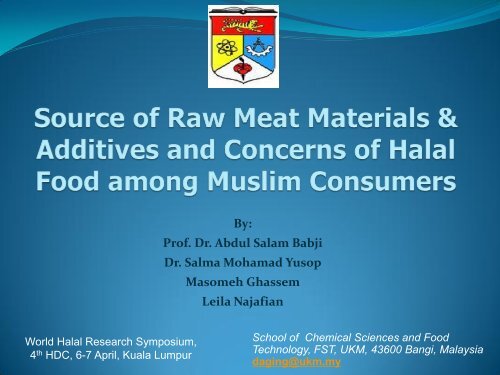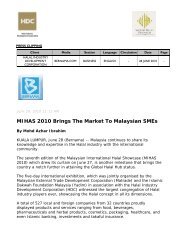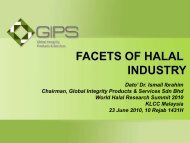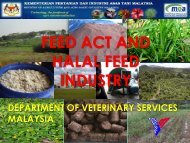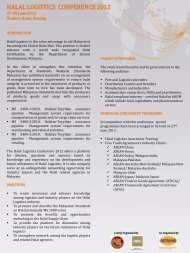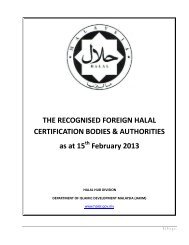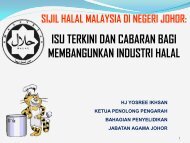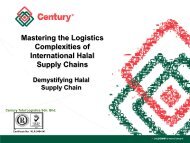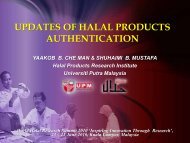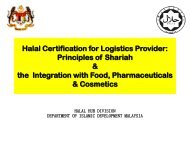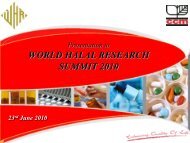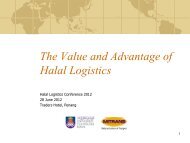Source of Raw Meat Materials & Additives and Concerns of ... - hdc
Source of Raw Meat Materials & Additives and Concerns of ... - hdc
Source of Raw Meat Materials & Additives and Concerns of ... - hdc
Create successful ePaper yourself
Turn your PDF publications into a flip-book with our unique Google optimized e-Paper software.
By:<br />
Pr<strong>of</strong>. Dr. Abdul Salam Babji<br />
Dr. Salma Mohamad Yusop<br />
Masomeh Ghassem<br />
Leila Najafian<br />
World Halal Research Symposium,<br />
4 th HDC, 6-7 April, Kuala Lumpur<br />
School <strong>of</strong> Chemical Sciences <strong>and</strong> Food<br />
Technology, FST, UKM, 43600 Bangi, Malaysia<br />
daging@ukm.my
INTRODUCTION
• The food industry, like any other<br />
industry, responds to the needs<br />
<strong>and</strong> desires <strong>of</strong> the consumer.<br />
• People all over the world are now<br />
more conscious about foods,<br />
health, <strong>and</strong> nutrition.<br />
• Many people are interested in<br />
foods that are organically<br />
produced without the use <strong>of</strong><br />
synthetic pesticides <strong>and</strong> other<br />
non-natural chemicals.
• Muslims follow the Islamic dietary code, <strong>and</strong> foods that<br />
meet that code are called halal (lawful or permitted).<br />
• Muslims are supposed to make an effort to obtain halal<br />
food <strong>of</strong> good quality. It is their religious obligation to<br />
consume only halal food.<br />
• The global market for halal products is estimated at USD<br />
580 billion a year <strong>and</strong> global halal trade is approximately<br />
USD 80 billion or 5% <strong>of</strong> total trade <strong>of</strong> agri-food products.<br />
• Rising income levels in key Muslim markets have led to<br />
higher consumption rates <strong>and</strong> therefore more<br />
opportunities for halal food producers.
ESTIMATED GLOBAL HALAL<br />
MARKET VALUE
Animal proteins, fats <strong>and</strong> by-products added to<br />
meat-based products economic, sensory, texture<br />
<strong>and</strong> flavor reasons.<br />
Animal proteins, hydrolysates, fats <strong>and</strong> skin readily<br />
available increased dem<strong>and</strong> (Babji, et.al, 1999).<br />
Today‟s consumers (Muslims) -- concern on HALAL,<br />
health, diet <strong>and</strong> wholesomeness products.<br />
Development <strong>of</strong> HALAL , healthful new meat basedproducts<br />
a pr<strong>of</strong>itable venture
• Health conscious consumer-driven market<br />
especially in selecting meat products (high fat,<br />
high cholesterol, unhealthy)<br />
• Manufacturers have to consider quality, consumer<br />
preference, overall acceptance, cost <strong>and</strong> pricing as<br />
equally important factors in the formulation <strong>of</strong><br />
fish, poultry <strong>and</strong> meat products.
HALAL FOODS
QURAN VERSE ON HALAL FOOD<br />
• “O ye people! Eat <strong>of</strong> what is on earth, lawful <strong>and</strong> good; <strong>and</strong> do not follow<br />
the footsteps <strong>of</strong> the Evil One, for he is to you an avowed enemy.” (Al-<br />
Baqarah:168)<br />
• “O you who believe (in the Oneness <strong>of</strong> Allah)! Eat <strong>of</strong> the good things<br />
that We have provided you, <strong>and</strong> be grateful to Allah if it is (indeed) He<br />
Whom you worship”. (Al-Baqarah:172)<br />
• “Eat <strong>of</strong> that which Allah hath provided for you lawful <strong>and</strong> good; but fear<br />
Allah, in Whom ye believe.” (Al Maidah:88)
• Halal is a term designating any object or an<br />
action which is permissible to use or engage in,<br />
according to Islamic law.<br />
• It is the opposite <strong>of</strong> Haram. Haram means<br />
prohibited.<br />
• The comm<strong>and</strong>ments <strong>of</strong> the Qur`an, the Holy<br />
Book, <strong>and</strong> religious ethics permit Muslims to<br />
consume only halal food.
.<br />
• Mashbooh is something questionable or doubtful,<br />
either due to the differences in scholars’ opinions or<br />
the presence <strong>of</strong> undetermined ingredients in a food<br />
product.<br />
• Makrooh is a term generally associated with<br />
someone’s dislike for a food product or, while not<br />
clearly haram, is considered dislikeable by some<br />
Muslims.<br />
• Zabiha or dhabiha is a term <strong>of</strong>ten used by Muslims in<br />
the U.S to differentiate meat that has been<br />
slaughtered by Muslims as opposed to being<br />
slaughtered by Ahlul Kitab or without religious<br />
connotation.
BASIS FOR SOME<br />
PROHIBITION
• Some scientists have attempted to explain or justify<br />
some <strong>of</strong> these prohibitions based on their scientific<br />
underst<strong>and</strong>ing as follows:<br />
‣Carrion <strong>and</strong> dead animals: are unfit for human<br />
consumption because the decaying process leads to<br />
the formation <strong>of</strong> chemicals which are harmful to<br />
humans.<br />
‣Blood: is drained from the body contains harmful<br />
bacteria, products <strong>of</strong> metabolism, <strong>and</strong> toxins
• Swine: serves as a vector for pathogenic worms to enter<br />
the human body. Infection by Trichinella spiralis <strong>and</strong><br />
Taenia solium are not uncommon. Fatty acid<br />
composition <strong>of</strong> pork fat has been mentioned as<br />
incompatible with the human fat <strong>and</strong> biochemical<br />
systems.<br />
• Intoxicants: are considered harmful for the nervous<br />
system, affecting the senses <strong>and</strong> human judgment.
SOME BIBLIBICAL VIEW
Mammals That Chew the<br />
Cud <strong>and</strong> Part the Ho<strong>of</strong><br />
Antelope<br />
Bison (buffalo)<br />
Caribou<br />
Cattle (beef, veal)<br />
Deer (venison)<br />
Elk<br />
Gazelle<br />
Giraffe<br />
Goat<br />
Hart<br />
Ibex<br />
Moose<br />
Ox<br />
Reindeer<br />
Sheep (lamb, mutton)<br />
Fish With Fins <strong>and</strong> Scales<br />
Anchovy<br />
Barracuda<br />
Bass<br />
Black pomfret (or monchong)<br />
Bluefish<br />
Bluegill<br />
Carp<br />
Cod<br />
Crappie<br />
Drum<br />
Flounder<br />
Grouper<br />
Grunt<br />
Haddock<br />
Hake<br />
Halibut<br />
Hardhead<br />
Herring (or alewife)<br />
Kingfish<br />
Mackerel(or corbia)<br />
Mahimahi (or dorado,<br />
dolphinfish[not to be confused<br />
with the mammal dolphin])<br />
“Clean” Animals<br />
Minnow<br />
Mullet<br />
Perch (or bream)<br />
Pike (or pickerel or jack)<br />
Pollack (or pollock or Boston<br />
bluefish)<br />
Rockfish<br />
Salmon<br />
Sardine (or pilchard)<br />
Shad<br />
Silver hake (or whiting)<br />
Smelt (or frost fish or ice fish)<br />
Snapper (or ebu, jobfish, lehi,<br />
onaga, opakapaka or uku)<br />
Sole<br />
Steelhead<br />
Sucker<br />
Sunfish<br />
Tarpon<br />
Trout (or weakfish)<br />
Tuna (or ahi, aku, albacore,<br />
bonito<br />
or tombo)<br />
Turbot (except European<br />
turbot)<br />
Whitefish<br />
Birds With Clean<br />
Characteristics<br />
Chicken<br />
Dove<br />
Duck<br />
Goose<br />
Grouse<br />
Guinea fowl<br />
Partridge<br />
Peafowl<br />
Pheasant<br />
Pigeon<br />
Prairie chicken<br />
Ptarmigan<br />
Quail<br />
Sagehen<br />
Sparrow (<strong>and</strong> other songbirds)<br />
Swan*<br />
Teal<br />
Turkey<br />
Insects<br />
Types <strong>of</strong> locusts that may<br />
include crickets <strong>and</strong><br />
grasshoppers
“Unclean” Animals<br />
Swine<br />
Boar<br />
Peccary<br />
Pig (hog, bacon, ham,<br />
lard, pork, most<br />
sausage <strong>and</strong><br />
pepperoni)<br />
Canines<br />
Coyote<br />
Dog<br />
Fox<br />
Hyena<br />
Jackal<br />
Wolf<br />
Felines<br />
Cat<br />
Cheetah<br />
Leopard<br />
Lion<br />
Panther<br />
Tiger<br />
Equines<br />
Donkey (ass)<br />
Horse<br />
Mule<br />
Onager<br />
Zebra (quagga)<br />
Groundhog<br />
Hippopotamus<br />
Kangaroo<br />
Llama (alpaca, vicuña)<br />
Mole<br />
Monkey<br />
Mouse<br />
Muskrat<br />
Opossum<br />
Porcupine<br />
Rabbit (hare)<br />
Raccoon<br />
Rat<br />
Rhinoceros<br />
Skunk<br />
Slug<br />
Snail (escargot)<br />
Squirrel<br />
Wallaby<br />
Weasel<br />
Wolverine<br />
Worm<br />
All insects except some in the<br />
locust<br />
family<br />
Shellfish<br />
Abalone<br />
Clam<br />
Conch<br />
Crab<br />
Crayfish (crawfish, crawdad)<br />
Lobster<br />
Mussel<br />
Oyster<br />
Scallop<br />
Shrimp (prawn)<br />
S<strong>of</strong>t body<br />
Cuttlefish<br />
Jellyfish<br />
Limpet<br />
Octopus<br />
Squid (calamari)<br />
Sea mammals<br />
Dolphin<br />
Otter<br />
Porpoise<br />
Seal<br />
Walrus<br />
Whale<br />
Other<br />
Armadillo<br />
Badger<br />
Bat<br />
Bear<br />
Beaver<br />
Camel<br />
Elephant<br />
Gorilla<br />
Marine Animals Without<br />
Fins <strong>and</strong> Scales<br />
Fish<br />
Bullhead<br />
Catfish<br />
Eel<br />
European Turbot<br />
Marlin<br />
Paddlefish<br />
Shark<br />
Stickleback<br />
Squid<br />
Sturgeon (includes most<br />
caviar)<br />
Swordfish<br />
Birds <strong>of</strong> Prey,<br />
Scavengers <strong>and</strong> Others<br />
Albatross<br />
Bittern<br />
Buzzard<br />
Condor<br />
Coot<br />
Cormorant<br />
Crane<br />
Crow<br />
Cuckoo<br />
Eagle<br />
Flamingo<br />
Reptiles<br />
Alligator<br />
Caiman<br />
Crocodile<br />
Lizard<br />
Snake<br />
Turtle<br />
Amphibians<br />
Blindworm<br />
Frog<br />
Newt<br />
Salam<strong>and</strong>er<br />
Toad
A MATTER OF HEALTH<br />
‣Are distinctions between clean <strong>and</strong> unclean meats a<br />
matter <strong>of</strong> health?<br />
‣Doctors <strong>of</strong>fer their view<br />
‣Scripture <strong>and</strong> medical research agree that modern<br />
lifestyles lived without reference to God’s laws <strong>and</strong><br />
design shorten life <strong>and</strong> hasten death’ (What the Bible<br />
says about Healthy Living, 1999)
HEALTH RISK TO HUMAN?<br />
• Beef, <strong>and</strong> fish that have scales <strong>and</strong> fins, is ideal for the<br />
health <strong>of</strong> humans.<br />
• Many l<strong>and</strong> animals God designed for food provide an<br />
additional benefit in that they generally eat grasses <strong>and</strong><br />
grains that were designed for food.<br />
• Almost all <strong>of</strong> the creatures on the unclean list are<br />
scavengers,” “in many cases, they don’t hunt for their own<br />
food; they eat the dead <strong>and</strong> decaying matter <strong>of</strong> our<br />
environment.<br />
• A catfish does that at the bottom <strong>of</strong> a pond; lobsters <strong>and</strong><br />
shrimp do it in the ocean. A pig will eat anything. Vultures,<br />
almost by definition, are known for their scavenger habits.
SWINE<br />
• Don Colbert, M.D., adds “besides being gluttons, swine are also extremely<br />
filthy animals.<br />
• Pork is also a very fatty meat. The toxins in pork are held especially in the<br />
fat, which is not isolated from the meat as can be the case in lean beef.<br />
• 3 <strong>of</strong> the 6 most common food-borne parasitic diseases <strong>of</strong> humans are<br />
associated with pork consumption. These includes toxoplasmosis,<br />
taeniasis or cysticercosis (caused by the pork tapeworm Taenia solium) <strong>and</strong><br />
trichinellosis.<br />
• “one reason for God’s rule forbidding pork is that the digestive system <strong>of</strong> a<br />
pig is completely different from that <strong>of</strong> a cow. It is similar to ours, in that<br />
the stomach is very acidic. Pigs are gluttonous. Their stomach acids<br />
become diluted because <strong>of</strong> the volume <strong>of</strong> food, allowing all kinds <strong>of</strong> vermin<br />
to pass through this protective barrier. Parasites, bacteria, viruses <strong>and</strong><br />
toxins can pass into the pig’s flesh.”
HORSES & RABBITS<br />
• Horses <strong>and</strong> rabbits, are not clean as they do not have<br />
spilt hooves. Studies showed that horse meat <strong>of</strong>ten<br />
contain viruses <strong>and</strong> parasites.<br />
• Rabbits, are the course <strong>of</strong> tularemia.
SHELLFISH<br />
• Shellfish can be placed in a body <strong>of</strong> water that is<br />
contaminated with cholera bacteria, <strong>and</strong> they will purify<br />
the water. Shrimp, oysters, crab, scallops <strong>and</strong> mussels are<br />
particularly efficient in this.<br />
• They filter large volumes <strong>of</strong> water every day. Sewage laden<br />
with chemicals, toxins <strong>and</strong> harmful bacteria, parasites <strong>and</strong><br />
viruses become concentrated in those shellfish.<br />
• This cause <strong>of</strong> cholera outbreaks in several areas has been<br />
traced to contaminated shrimp, crab, oysters <strong>and</strong> clams.
CATFISH<br />
CATFISH COLLAGEN<br />
What is Collagen?<br />
Collagen<br />
• An insoluble fibrous protein that occurs in vertebrates<br />
as chief constituent <strong>of</strong> connective tissue fibrils <strong>and</strong> in<br />
bones. Constitute >25% <strong>of</strong> protein mass in the human<br />
body.<br />
• is obtained from animal skins <strong>and</strong> bones
• Dr. Russell’s conclusion “although swine help clean the<br />
earth, <strong>and</strong> shellfish <strong>and</strong> catfish are ideally designed to<br />
purify the water, we don’t want to eat what they clean<br />
up!!”
MEAT & POULTRY
• Conditions <strong>and</strong> Method <strong>of</strong> Slaughtering<br />
(Dhabh or Zabh*)<br />
Dhabh is a clearly defined method <strong>of</strong> killing<br />
an animal for the sole purpose <strong>of</strong> making its<br />
meat fit for human consumption.<br />
• The Slaughter Person<br />
The person performing the act <strong>of</strong> dhabh must<br />
be <strong>of</strong> sound mind <strong>and</strong> an adult Muslim.
• The Instrument<br />
The knife used to perform dhabh must be<br />
extremely sharp to facilitate quick cutting <strong>of</strong> the<br />
skin <strong>and</strong> severing <strong>of</strong> blood vessels to enable the<br />
blood to flow immediately <strong>and</strong> quickly.<br />
• The Cut<br />
The incision should be made in the neck at some<br />
point just below the glottis <strong>and</strong> the base <strong>of</strong> the<br />
neck.
• The Invocation<br />
Tasmiyyah or invocation means pronouncing the<br />
name <strong>of</strong> God by saying Bismillah before cutting<br />
the neck.<br />
• Abominable Acts in Slaying <strong>of</strong> Animal<br />
It is abominable to first throw the animal down on<br />
its side <strong>and</strong> sharpen the knife afterwards.
• Animal Fat <strong>and</strong> Protein<br />
<strong>Meat</strong> <strong>and</strong> poultry products are not only<br />
consumed as staple food items, but are also<br />
converted into further processed ingredients<br />
to be used in formulating a myriad <strong>of</strong><br />
nonmeat food products.<br />
Animal fat is purified <strong>and</strong> converted into<br />
animal shortening, emulsifiers, as well as<br />
other functional food ingredients
• Feathers <strong>and</strong> hair can be converted into amino<br />
acids.<br />
• Such ingredients would be halal only if the<br />
animals are halal <strong>and</strong> all precautions are taken to<br />
eliminate cross-contamination.<br />
• Flavors <strong>and</strong> Flavorings<br />
For formulating halal food products, the<br />
manufacturer has to make sure that any flavors,<br />
proprietary mixes, or secret formulas are halal <strong>and</strong><br />
free from doubtful materials.
IMPORT REQUIREMENTS<br />
FOR DIFFERENT COUNTRIES
MALAYSIA<br />
• In 1982, the Malaysian government issued regulations making it<br />
m<strong>and</strong>atory for all meat (beef, mutton, veal, <strong>and</strong> poultry)<br />
imported into Malaysia to be halal certified <strong>and</strong> such meat to<br />
originate only from meat plants approved by the Islamic Affairs<br />
Division <strong>of</strong> the Prime Minister’s Department <strong>and</strong> the<br />
Department <strong>of</strong> Veterinary Services, Malaysia.<br />
• Under the Malaysian regulations, all halal certificates for meat<br />
<strong>and</strong> poultry must be issued <strong>and</strong> signed by an Islamic center<br />
accredited to do halal certification by JAKIM (Jabatan Kemajuan<br />
Islam Malaysia).<br />
• Slaughterhouses for producing such meat <strong>and</strong> poultry products<br />
must also be approved by both Malaysian government agencies<br />
(JAKIM <strong>and</strong> the Department <strong>of</strong> Veterinary Services).
SINGAPORE<br />
• In Singapore, all imported meat (including poultry)<br />
<strong>and</strong> meat products must be halal certified by an<br />
Islamic organization in the country <strong>of</strong> export <strong>and</strong><br />
approved by MUIS (Majlis Ugama Islam Singapura).<br />
• Singapore is also a member <strong>of</strong> the ASEAN Adhoc<br />
Working Group, committee on halal food<br />
guidelines.
INDONESIA<br />
• Majelis Ulama Indonesia (MUI), has assigned the<br />
responsibility to coordinate halal activities to an<br />
institute called the Assessment Institute for Foods,<br />
Drugs <strong>and</strong> Cosmetics (AIFDC).
MIDDLE EAST<br />
COUNTRIES Gulf St<strong>and</strong>ards<br />
• All countries in the Middle East, Gulf, <strong>and</strong> the rest<br />
require that imported products be accompanied with a<br />
halal certificate issued by a recognized Islamic<br />
organization in the country <strong>of</strong> export.<br />
• the certificates be endorsed by the National U.S. Arab<br />
Chamber <strong>of</strong> Commerce or the consulate <strong>of</strong> the<br />
importing country before exports can commence.
SOUTH ASIA<br />
• The South Asian countries <strong>of</strong> India, Pakistan,<br />
Bangladesh, <strong>and</strong> Sri Lanka also import halal products<br />
for consumption, especially for food service.<br />
• Pakistan operate under guidelines similar to those in<br />
Malaysia <strong>and</strong> voluntarily require halal certificates from<br />
their vendors not only for meat <strong>and</strong> poultry but also<br />
for processed food items
OTHER COUNTRIES<br />
• Many other countries include Egypt, Iran, Turkey,<br />
Thail<strong>and</strong>, Philippines, South Africa, <strong>and</strong> Australia,<br />
may also require halal certificates to accompany<br />
imported food products either under a formal program<br />
or informally.
PACKAGING & LABELLING
• Packing the product is the final step in<br />
the manufacture <strong>of</strong> processed meat <strong>and</strong><br />
labeling them to accurately identify<br />
them with halal markings.
HALAL FOOD MARKET
• Considering population<br />
growth rates <strong>and</strong><br />
increasing incomes, it is<br />
estimated that in the<br />
future, halal food may account<br />
for 20% <strong>of</strong> world<br />
trade in food products.<br />
• Rising income levels in key<br />
Muslim markets have led<br />
to higher consumption<br />
rates <strong>and</strong> therefore more<br />
opportunities for halal<br />
food producers.
• In this market, companies like Carrefour, Al<br />
Islami Foods <strong>and</strong> <strong>Meat</strong> & Livestock Australia<br />
are developing their production in order to<br />
grab the opportunities presented by the Halal<br />
food market.
<strong>Meat</strong> Product Development
Processed <strong>Meat</strong> Products<br />
Def: whole muscle product that has been transformed into a manufactured<br />
product by chemical, enzymatic, or mechanical treatment.<br />
From the animal<br />
<strong>Meat</strong> cuts<br />
<strong>Meat</strong> trimmings<br />
Fat<br />
Bone<br />
Retail cuts<br />
Steak<br />
Bacon<br />
Type <strong>of</strong> products<br />
Emulsion& fermented sausages<br />
Liver pâté<br />
<strong>Meat</strong> balls<br />
Hamburgers<br />
Restructured meat<br />
Frying fat, fat for bakery &<br />
margarine<br />
Converted to feeding stuff
Constrain <strong>Meat</strong> Product development<br />
• Texture <strong>and</strong> bindings are two main problems<br />
encountered with these products.<br />
• Good binding, mechanical processes employed to<br />
extract the salt soluble meat proteins.<br />
• Mixing time, temperature<br />
• Quality control <strong>of</strong> raw products <strong>and</strong> product<br />
development must be integrated.
<strong>Meat</strong> Product Processing
<strong>Meat</strong> Product Processing<br />
• GRINDING MEAT INGREDIENTS<br />
• ADDING NON-MEAT INGREDIENTS<br />
• BLENDING, STUFFING, MARINATIN<br />
• MASSAGING, RESTRUCTURING
• PROCESSES<br />
• ENZYMES, SCP, BIOACTIVES<br />
• FERMENTATION PRODUCTS<br />
• MICROBIAL P-HYDROLYSIS PRODUCTS<br />
• BYPRODUCTS-MDM, CT, CASINGS<br />
• FUNCTIONAL FOODS & DRINKS<br />
• PET FOOD AND ANIMAL FEED
Advanced <strong>Meat</strong> Processing<br />
• Hydrodynamic pressure processing<br />
• Functional Bioactive Peptides<br />
• Nitrite free meat products<br />
• Use <strong>of</strong> Bacteriocins against pathogens<br />
• <strong>Meat</strong> bacterial starters<br />
• Modified atmosphere packaging<br />
• Active packaging <strong>of</strong> meat products.
ATTENTION!<br />
Advances in Processing Technologies<br />
• THORACIC STICKING SLAUGHTER<br />
• ELECTRICAL STUNNING<br />
• CAPTIVE BOLT STUNNING<br />
• KOBI BEEF, KOSHER CUTS<br />
• ORGANIC MEAT PRODUCTS<br />
• GELATIN, BIRD NEST, SHARK FIN SURIMI AND MANY<br />
SURIMI PDTS.
Issues in Processed <strong>Meat</strong><br />
Products<br />
• <strong>Raw</strong> materials<br />
• Slaughtering<br />
• Processing operations/equipment<br />
• Packaging/Storage/Transportation<br />
• Food ingredients <strong>and</strong> additives<br />
• Food adulteration<br />
• Biotechnology <strong>and</strong> GMF (genetically modified food)<br />
• Food safety<br />
• Food quality aspects (aspect <strong>of</strong> „Thoyyiba‟)
Blood <strong>and</strong> Blood Plasma
• Adding blood <strong>and</strong> blood plasma meat <strong>and</strong> meat<br />
product quality.<br />
• Animal proteins develop the characteristic <strong>of</strong><br />
protein matrix chain technology in meat.<br />
• Fat <strong>and</strong> water binding.<br />
• Blood plasma from slaughter process good for<br />
characterization <strong>of</strong> functional protein.<br />
• Increasing protein content in product.
• Blood plasma <strong>and</strong> red color<br />
• Plasma powder shape or liquid<br />
• Much adding on sausage product <strong>and</strong> raw<br />
material (surimi), MDM, luncheon meats.<br />
• Why blood added?? WHC, FBC, Emulsion <br />
elasticity, product texture.
• Cooking process coagulation <strong>of</strong> plasma, fat <strong>and</strong><br />
water binding.<br />
• Mix in flavorings , marinades, water @ 2%,<br />
freeze, flakes, essence.<br />
• Usually, blood plasma will be adding with<br />
water/ice on the meat grinding.
• pH <strong>of</strong> blood plasma are around 6-7, good <br />
WHC/WBC<br />
• More effective to water binding in meat with blood<br />
plasma pr<strong>of</strong>it<br />
• Blood plasma also injected in the meat lump more<br />
juiciness.<br />
• Tin food-plasma meat compact <strong>and</strong> more tasty.
• Red color from blood is added In sausage fermentation<br />
/processing.<br />
• In labeling, the ingredient contents is vaguely mentioned,<br />
because <strong>of</strong> low percent <strong>of</strong> plasma . (
RED PALM FAT CHICKEN FRANKFURTER
RETORTED FRANKFURTER
FEED /LIVESTOCK<br />
• FEED livestock rich on plasma, blood, viscera,<br />
bone, meal, hormones, enzymes, fur, fat, cull<br />
animals carcasses.<br />
• SeDAP - Spray dried animal protein.<br />
• Piglet protein source.<br />
• Enzyme Technology - porzyme Xylanase ><br />
performance <strong>of</strong> animal.
Nutricines<br />
Nutrients that may also be medicines<br />
Lysophosphotidylcholine – eg Nutricine<br />
Oligo Zn+Cu<br />
Enzymes customization<br />
MicroPlus feed flavor<br />
Phytogenic feed additives<br />
Proteinated – Zn, Mn, Fe, Cu<br />
Glycinated – ZnGly 20% + 28%<br />
Methionated – MnMet 10% +40%<br />
Phyzyme - Phytoses
Detection <strong>of</strong> Non-Fish Plasma Protein<br />
in Surimi based Products<br />
• Surimi with good gelling properties <strong>and</strong> smooth texture<br />
is required to produce a high quality <strong>and</strong> product.<br />
• Plasma form a strong gel & proteolytic enzymes<br />
inhibitor properties.<br />
• The usage <strong>of</strong> various animals (swine & bovine) plasma<br />
protein.<br />
• Plasma NON-HALAL<br />
• Method (identification) DNA method (more reliable)
• Three out <strong>of</strong> 12 surimi-based products tested shows<br />
POSITIVE results on amplification using BOVINE<br />
specific primer (beef).<br />
• The HALAL status <strong>of</strong> these products are<br />
DOUBTFUL for Muslim consumers.
The Slaughter
Ritual Slaughter - Zibah<br />
• Animals should be slaughtered according to Islam ritual.<br />
• Exceptions: animals shot during hunting <strong>and</strong> regulations for<br />
wild life (5:5)<br />
Ritual slaughter<br />
• Licensed Muslim slaughterer should slaughter invocating the<br />
name <strong>of</strong> Allah.<br />
• The animal must be alive <strong>and</strong> healthy at the moment <strong>of</strong><br />
slaughter.<br />
• Animal skin or fur or feathers must be clean prior to slaughter,<br />
free <strong>of</strong> faeces, mud or other unhygienic substances.<br />
• Cut the throat, jugular vein, carotid artery <strong>and</strong> gullet with one<br />
stroke without damage <strong>of</strong> the spinal cord stunning is not<br />
permitted.<br />
• Flowing blood drain out by natural convulsion.
The Slaughter<br />
• The animal is calmly led to slaughter ground, face in<br />
the direction <strong>of</strong> the Ka‟bah (this is highly encouraged)<br />
<strong>and</strong> with the name <strong>of</strong> Allah, pronounced over it, then<br />
slaughtered.<br />
• The slaughterer is instructed to slaughter the animal<br />
away from the view <strong>of</strong> the other animals to be<br />
subsequently slaughtered.<br />
• After the slaughtered, the animal is left to struggle,<br />
also outside the view <strong>of</strong> the others animals.
The Slaughter<br />
1. Pronouncing the name <strong>of</strong> Allah during<br />
slaughter<br />
2. Treating the animal for slaughter with kindness<br />
3. The cutting instrument used slaughter<br />
4. The actual slaughter<br />
5. Cleaning
1. Pronouncing the name <strong>of</strong> Allah<br />
The Islamic slaughter necessitates the pronouncing the<br />
name <strong>of</strong> Allah over the animal during slaughter.
2. Treating the Animal <strong>of</strong> Slaughter with<br />
Kindness<br />
• The main intent in the tradition related is to be kind<br />
<strong>and</strong> to spare the animal necessary suffering.<br />
• Putting the animal to be slaughtered under stress also<br />
has adverse affects on the quality <strong>of</strong> the carcass which<br />
deteriorates if the animal is frightened.
A. The Effect <strong>of</strong> Stress on the Texture <strong>and</strong><br />
Quality <strong>of</strong> the <strong>Meat</strong><br />
Before<br />
During<br />
Calm & Rest<br />
Struggling<br />
should also<br />
be minimized<br />
Preserve the glycogen<br />
stores present in the meat
B. The Effect <strong>of</strong> Stunning<br />
• Used to render the animal unconscious prior to<br />
slaughtering to avoid wild movement during<br />
slaughtering.<br />
• Two types <strong>of</strong> mechanical stunning:<br />
a. Captive bolt stunners<br />
b. Non-penetrating concussion stunners<br />
• The use <strong>of</strong> stunning equipment must be under the<br />
supervision <strong>of</strong> a trained Muslim.
a. Captive Bolt Stunning<br />
• Uses a narrow bolt with a sharp, circular end, which is<br />
driven a short distance into the brain by using a blank<br />
cartridge or compress air.<br />
• This method destroys the animal‟s brain, rendering it<br />
unconscious, <strong>and</strong> leaves a round hole in the animal‟s<br />
skull.
. Non-Penetrative Concussion<br />
Method<br />
• Used a wide mushroom-shaped head, also powered by<br />
a blank cartridge or compressed air.<br />
• Not penetrate the brain skull, but delivers a knock out<br />
blow to the skull which leaves the animal unconscious.
3. The Cutting Instrument<br />
• Use a sharp cutting instrument: the very sharp cutting<br />
instrument used would allow for a smooth & quick cut<br />
across the animal‟s throat.<br />
• Use a clean cutting instrument: necessary for all<br />
equipment used to be clean to prevent such<br />
contamination from occuring.
4. The Actual Slaughter<br />
• The head not be cut <strong>of</strong>f from the body.<br />
• The slaughter should severe completely the respiratory<br />
tract (trachea), gullet (esophagus), the carotid arteries<br />
<strong>and</strong> the jugular veins, in one stroke to bring about an<br />
immediate <strong>and</strong> massive haemorrhage, without<br />
severing the spinal cord.
The Importance <strong>of</strong> Struggling After<br />
the Slaughter<br />
• Maximal struggling after slaughter ample loss <strong>of</strong><br />
blood.<br />
• Blood is excellent medium for microbial growth.<br />
• The poor/minimal struggling <strong>of</strong> the animal killed in<br />
the non-Islamic way allows the blood to remain in the<br />
body tissues.
Thoracic Sticking After the<br />
Slaughter<br />
A method that sever major blood vessels anterior to<br />
the heart, in the thoracic cavity <strong>of</strong> the animal,<br />
immediately after slaughter to hasten death<br />
Does the animal actually dies from the ‘halal’<br />
slaughter itself, or through the act <strong>of</strong> thoracic<br />
sticking ?????
5. Cleaning<br />
• Must be cleaned with running water that is clear from<br />
„najis‟ or filth (blood & excrement).<br />
• A high st<strong>and</strong>ard <strong>of</strong> hygiene should always be strictly<br />
maintained<br />
• <strong>Meat</strong> <strong>and</strong> poultry are easily infected with bacteria –<br />
Salmonella
Mechanical Slaughter<br />
• Mechanical transportation but manual<br />
slaughter: Chickens are transported to the place <strong>of</strong><br />
slaughter through a conveyer belt <strong>and</strong> are manually<br />
slaughtered. This procedure is unanimously<br />
permissible <strong>and</strong> recommended<br />
• Mechanical transportation <strong>and</strong> slaughter:<br />
Chickens are transported by means <strong>of</strong> the conveyer<br />
belt to the mechanical slaughter blade. Once the<br />
mechanical plant comes into operation, the blade also<br />
comes into operation <strong>and</strong> cuts the chicken. This<br />
procedure is not permissible.
Stunning<br />
• Germany : Religious slaughter without pre-stunning<br />
is allowed.<br />
• EU : Religious slaughter without pre-stunning is<br />
allowed.<br />
• Egypt : University Al - Azhar in Cairo has accepted<br />
stunning with electro shocks. Not according to the<br />
opinion <strong>of</strong> the majority <strong>of</strong> Muslims which consider<br />
such slaughter as Haram.<br />
• UK : Exception for Islamic slaughter without stunning<br />
is provided in UK regulation.
Mechanical Methods <strong>of</strong> Stunning<br />
Mainstream Slaughter<br />
Captive bolt : Widely used for all farm animals <strong>and</strong><br />
rabbits. Gun powder (cartridge), compressed air <strong>and</strong><br />
spring under tension drive bolts through the skull <strong>of</strong><br />
animals.<br />
Concussion stunning : A mechanically operated<br />
instrument delivers a blow to the brain <strong>and</strong><br />
concusses the brain. Used for cattle, sheep, calves,<br />
rabbits.<br />
Free bullets : Used for animals difficult to h<strong>and</strong>le<br />
such as wild pigs, bison, deer, horses or in<br />
emergencies.
Gas Stunning<br />
Mainstream Slaughter<br />
• Carbon dioxide: Carbon dioxide is used to stun<br />
pigs in the UK <strong>and</strong> other EU countries. Pigs<br />
exposed to 90% CO 2 die within approx. 5<br />
minutes, but times vary <strong>and</strong> can be significantly<br />
longer.<br />
• Carbon dioxide <strong>and</strong> argon: This gas mixture is<br />
used for stun/kill chickens <strong>and</strong> turkeys.
Electrical Stunning<br />
Mainstrem Slaughter<br />
• Head-only stunning: An electric current is applied<br />
to the head which is supposed to cause temporary loss<br />
<strong>of</strong> consciousness.<br />
• Cardiac arrest stunning: An electric current is<br />
either sent through the head <strong>and</strong> body at the same<br />
time to span the brain <strong>and</strong> heart or is sent though the<br />
head first <strong>and</strong> then across the chest.<br />
• Waterbath stunning: Used for poultry. Birds are<br />
shackled upside down on a moving conveyor which<br />
carries them to an electrified water bath into which<br />
their heads are supposed to be immersed.
Stunning<br />
Islam Interpretation<br />
• Gassing strangulation: Are considered as cruel <strong>and</strong><br />
unlawful in Islam, therefore chemical gassing should<br />
not be used as a stunning method.<br />
• Concussion: Animals that die from a violent blow are<br />
haram.<br />
• Captive bolt pistol, water bath :Animals that die<br />
from a fall – some Muslims have interpreted this<br />
comm<strong>and</strong> to mean that if an animal has died from<br />
concussion or drowning (as a cow falling in a well<br />
would be killed by drowning) it is forbidden.
Electrical Stunning<br />
Islam Experts Interpretation<br />
• Dr Abdel Aziz El Khayat, Dean <strong>of</strong> the Faculty <strong>of</strong> Islamic<br />
Law, University <strong>of</strong> Jordan<br />
• Some say electrical stunning is legal so long as the animal<br />
is still alive when slaughtered <strong>and</strong> so long as the motive<br />
is to ease suffering <strong>and</strong> quicken the process.<br />
• Others say it is forbidden because the shock can cause pain;<br />
quickens decay <strong>of</strong> the flesh; causes haemorrhaging so<br />
diseases can't be checked for <strong>and</strong> may kill the animal<br />
outright.<br />
• Van de Wals <strong>and</strong> Warrinton: All stunning methods trigger<br />
a massive secretion <strong>of</strong> epinephrine.
Electrical Stunning<br />
Islam Experts Interpretation<br />
New Zeal<strong>and</strong> <strong>and</strong> Australia<br />
• New Zeal<strong>and</strong> has developed an electrical<br />
stunning apparatus that meets Muslim st<strong>and</strong>ard.<br />
• Head-only electric stunning prior to Muslim<br />
slaughter is used in almost all sheep slaughter<br />
plants in New Zeal<strong>and</strong> <strong>and</strong> Australia.
Electrical Stunning<br />
Islam Experts Interpretation<br />
Dr Ahmad Sakr, expert on Halal certification in<br />
USA:<br />
• He says it is NOT Halal because <strong>of</strong> the effect<br />
electric shock has on blood drainage.<br />
• Using electric shock means that all <strong>of</strong> the animal's<br />
blood does not leave its body, because electric<br />
shock affects the central nervous system.
Captive Bolt Stunning<br />
Sheikh Aboul Yusr Abdin: Many Muslims do believe<br />
(<strong>and</strong> many do not!) that stunning is permitted so long as<br />
the animal is killed by cutting the throat.<br />
It is more acceptable to stun cows to speed up throughput<br />
but much less so to stun smaller animals which are easier<br />
to h<strong>and</strong>le.<br />
Dr Abdel Aziz El Khayat: Most Muslims allow the<br />
captive bolt.<br />
Australia, New Zeal<strong>and</strong> <strong>and</strong> Irel<strong>and</strong>: Non-penetrating<br />
concussion stunning prior to slaughter has received<br />
approval from some Muslim authorities.
The Talmud<br />
• Detailed anatomical information what is to be done<br />
during slaughter <strong>and</strong> the subsequent post-mortem<br />
inspection.<br />
• The Jewish religious codes require that allowed<br />
animals be slaughtered by a specially trained Jewish<br />
male called "shochet" using a special knife, called the<br />
"chalef".<br />
• While the Muslims allow any believing Muslim man<br />
or women, to slaughter allowed animals.
Animal Slaughter in Abattoir<br />
• Constant supervision <strong>of</strong> a Halal certifier.<br />
• The premises, machinery <strong>and</strong> equipment must be<br />
cleansed according to Islamic Shariah before any<br />
production takes place.<br />
• The Slaughterer must be a mature <strong>and</strong> pious Muslim<br />
• Only acceptable live animals <strong>and</strong> birds can be<br />
slaughtered.
Animal Slaughter in Abattoir<br />
• The slaughter must be done manually using a<br />
stainless steel knife.<br />
• Facilities must be available for rinsing the knife<br />
after each kill.<br />
• The slaughterer must sever the respiratory tract,<br />
oesophagus <strong>and</strong> jugular vein.<br />
• The animal must be completely dead before<br />
skinning takesplace.<br />
• Only Halal animals <strong>and</strong> birds are Halal<br />
Slaughtered.
Evaluation <strong>of</strong> Religious Slaughter<br />
• Stressfulness <strong>of</strong> restraint methods.<br />
• Pain perception during the incision.<br />
• Latency <strong>of</strong> onset <strong>of</strong> complete insensibility.
Restraint<br />
Europe<br />
• The casting pen inverts cattle onto their backs,<br />
being more stressful than upright restraint<br />
devices.<br />
• Cattle resist inversion <strong>and</strong> twist their necks in an<br />
attempt to right their heads.
Restraint Devices<br />
• Weinberg casting pen: It is very stressful.<br />
• Facomia pen: Less stressful than Weinberg pen<br />
but upright restraint would be better.<br />
• US: Poorly designed upright restraint boxes apply<br />
excessive pressure to the thoracic <strong>and</strong> neck areas<br />
<strong>of</strong> cattle.
Upright restraint device according to Gr<strong>and</strong>in
Loss <strong>of</strong> Conciousness<br />
After Incision<br />
• Sheep <strong>and</strong> goats: 2 to 15 seconds<br />
• Cattle: immediately to 30 seconds. Calm cattle will<br />
usually collapse within 10 to 15 seconds.
Upright Restrain<br />
Upright restraint:<br />
• Special device by Gr<strong>and</strong>in Good upright restraint<br />
equipment is available for low stress, comfortable<br />
restraint <strong>of</strong> sheep, calves <strong>and</strong> cattle.<br />
• Excessive bending <strong>of</strong> the neck should be avoided.<br />
For that, the bovine's forehead should be parallel<br />
to the floor.
Welfare Aspects <strong>of</strong> Slaughter<br />
• Many welfare concerns in Europe are centered on<br />
restraint, driven by their concerns about forceful<br />
immobilization <strong>and</strong> clamping <strong>of</strong> cattle<br />
• A failure rate <strong>of</strong> 3 to 5 in captive bolt stunning<br />
requiring a second shot could be avoided with proper<br />
head restrain devices.
Animal Slaughter Research<br />
University <strong>of</strong> Hanover:<br />
• Germany Pr<strong>of</strong>essor Schultz <strong>and</strong> Dr. Hazim used<br />
Electroencephalograph (EEG) <strong>and</strong> electrocardiogram<br />
(ECG) to compare the pain caused by Islamic slaughter<br />
<strong>and</strong> western method using captive bolt stunning.
Halal Production Requirements for<br />
<strong>Meat</strong> & Poultry<br />
• The preferred feed for halal poultry should be devoid<br />
<strong>of</strong> any animal by-products/other scrap materials.<br />
• The use <strong>of</strong> hormones in chickens for egg or meat<br />
production is discouraged, some scholars call it haram<br />
whereas others ignore it.
Mechanical Slaughter <strong>of</strong> Birds<br />
• A muslim while pronouncing the name <strong>of</strong> Allah<br />
switces on machine.<br />
• In commercial poultry processing, generally the<br />
machine does not properly cut 5-10% <strong>of</strong> the birds.<br />
• 2 slaughter persons might be required to accomplish<br />
these requirements depending on the line speed &<br />
efficiency<br />
• The machine must be stopped during breaks <strong>and</strong><br />
restarted by previous procedure.
Industrial Habits<br />
Slaughter by machines: Several supermarket chains have<br />
sold chicken slaughtered by machines with Halal labeling.<br />
Consumers do not agree with that.<br />
Product change on line: Changing between different<br />
products <strong>of</strong> the same category with meat <strong>and</strong> vegetarian<br />
products on a same line is practiced in actual food industry.<br />
However, changing from meat product to a vegetarian one,<br />
haram meat <strong>and</strong> animal fat can contaminate this product
Industrial Habits<br />
Cross-over: Halal food should be free <strong>of</strong> unlawful<br />
ingredients, or contamination, even in low level. Crossover<br />
should not be tolerated<br />
False claims: a claim on vegetarian food <strong>of</strong> a fast food<br />
chain was not sustained as the company had to admit <strong>of</strong><br />
having used beef extract on their French fries <strong>and</strong> hash<br />
browns.<br />
Halal is a distinct set <strong>of</strong> dietary rules which should be<br />
recognized by all the businesses <strong>and</strong> global food<br />
industry <strong>and</strong> must be clearly separated from vegetarian<br />
diet, vegan diet, organic food <strong>and</strong> Hindu food.
Organizations & Companies<br />
Certifying Muslim Food<br />
World Halal Food Council: The Council Congress<br />
meeting on 2001 was looking forward to greater<br />
cooperation among Halal certifying organizations.<br />
Halal certifying organizations:<br />
• IFANCA (Islamic Food <strong>and</strong> Nutrition Council <strong>of</strong><br />
America) (USA)<br />
• ISNA-Canada (Islamic Society <strong>of</strong> North America-<br />
Canada)<br />
• The Muslim Food Board ( UK ) It is one company<br />
which investigates <strong>and</strong> certifies foods.
Codex Alimentarius<br />
Labeling <strong>of</strong> Halal Food CAC/GL-24-1997<br />
• The Codex Alimentarius Commission accepts that<br />
there may be minor differences in opinion in the<br />
interpretation <strong>of</strong> lawful <strong>and</strong> unlawful animals <strong>and</strong> in<br />
the slaughter act, according to the different Islamic<br />
Schools <strong>of</strong> Thought.
Codex Alimentarius<br />
Haram Animal Foods<br />
Pigs <strong>and</strong> boars.<br />
Dogs, snakes <strong>and</strong> monkeys.<br />
Carnivorous animals with claws <strong>and</strong> tusks such as lions, tigers, bears, <strong>and</strong><br />
similar animals.<br />
Birds <strong>of</strong> prey with talons, such as eagle, vulture <strong>and</strong> similar animals.<br />
Pests like rats, centipedes, scorpions <strong>and</strong> similar animals.<br />
Animals which according to Islamic laws should not be killed such as ants,<br />
bees <strong>and</strong> woodpecker.<br />
Repulsive animals such as lice, flies worms <strong>and</strong> similar animals.<br />
Animals which can live on l<strong>and</strong> <strong>and</strong> in water such as frogs, crocodiles <strong>and</strong><br />
similar animals.<br />
Mules <strong>and</strong> similar animals.<br />
All poisonous <strong>and</strong> dangerous animals <strong>of</strong> the sea.<br />
All animals which have been slaughtered disregarding the Islamic laws.<br />
Blood.
Other Problems with Halal Food<br />
Dutch chicken with animal protein hydrolysates:<br />
This is not allowed as the consumer does not want to<br />
have other animal proteins than chicken in frozen<br />
poultry.
Other Problems with Halal Food<br />
Campylobacter<br />
• Chicken: Campylobacter is a food borne bacteria<br />
which is present in free living birds <strong>and</strong> nowadays in<br />
30 to 70% in broiler chicken herds <strong>and</strong> laying hens.<br />
• Milk: Contamination <strong>of</strong> milk results from an infection<br />
<strong>of</strong> the udder or contact with manure <strong>of</strong> herds where<br />
campylobacter jejuni has developed a specific<br />
resistance to this environment.
Other Problems with Halal Food<br />
Campylobacter<br />
Surface water: Untreated drinking water is a source <strong>of</strong><br />
infection <strong>of</strong> cattle <strong>and</strong> humans.<br />
Bovine meat: The bovine meat from abattoir have very low<br />
levels <strong>of</strong> Campylobacter bacteria. This seems to be due to<br />
drying <strong>and</strong> refrigeration techniques from these plants.<br />
Other infection sources: <strong>Raw</strong> sea foods <strong>and</strong> contact with<br />
pets.<br />
Resistance to antibiotics: High resistance <strong>of</strong><br />
Campylobacter jejuni <strong>and</strong> Campylobacter coli to<br />
erytromicine <strong>and</strong> fluorochinolone are increasing worldwide.
Symbols for Halal <strong>and</strong> Kosher<br />
• Symbols for Halal: If the product is Halal certified it<br />
has a Halal symbol which is a "H" under Triangle on<br />
the product.<br />
• Symbol for kosher foods: The symbol for kosher is a<br />
U or UD, Circler K, Triangle K, CRC, COR, V, kuf K<br />
which appears on the food product.
Gelatin in Halal Food<br />
Production
<strong>Source</strong>s <strong>of</strong> Gelatin<br />
• Common sources <strong>of</strong> gelatin are pigskin, cattle<br />
hides, cattle bones, & less frequently, fish skins &<br />
poultry skins.<br />
• GENERALLY – a product does indicate the source<br />
<strong>of</strong> the gelatin.<br />
• Halal gelatin produce Europe, India, Pakistan.
Status Gelatin in Islam<br />
• Halal status depend on the nature <strong>of</strong> raw<br />
materials used manufacture<br />
• Two types <strong>of</strong> gelatin:<br />
• From pork skin<br />
• From cattle <strong>and</strong> calf skins/from demineralized<br />
cattle bones – usually from animal slaughtered by<br />
non-muslims.<br />
• Fish skin gelatin is halal as long as it is free from<br />
contamination from other source <strong>and</strong> is made<br />
from fish species accepted by Muslims
Bioactive Peptides from<br />
<strong>Meat</strong> Proteins
Functional Foods<br />
„Processed foods having disease-preventing <strong>and</strong><br />
health-promoting benefits in addition to their<br />
nutritional value‟<br />
• Much attention has been paid to physiological<br />
functions <strong>of</strong> foods. Progress has been made in the<br />
development <strong>of</strong> functional foods, such as functional<br />
dairy products.
Direction <strong>of</strong> <strong>Meat</strong> Products<br />
“The meat industry must adapt to<br />
the new concepts in nutrition.<br />
There is now a potential market<br />
for functional foods, based on the<br />
principle <strong>of</strong> added value linked to<br />
health benefits, which is one <strong>of</strong><br />
the main trends in the<br />
development <strong>of</strong> food products.”<br />
“New approaches for the development <strong>of</strong> functional meat products”<br />
(Chapter 11) Jiménez-Colmenero, Reig & Toldrá(2006)
Bioactive Peptides from <strong>Meat</strong><br />
Protein<br />
• <strong>Concerns</strong> about health leads to much attention to<br />
physiological functions <strong>of</strong> foods.<br />
• Anti carcinogen, antimutagen, antioxidant, antiaging.<br />
• Develop new foods-functional ingredients.
Bioactive Peptides Derived from<br />
<strong>Meat</strong>/Serum Proteins<br />
• ACE Inhibitory <strong>and</strong> antihypertensive peptides<br />
• Opioid peptides - lower systolic/diostolic BP<br />
• Immunomodulatory peptides - immune building<br />
• Antimicrobial peptides<br />
• Prebiotic peptides<br />
• Mineral – binding peptides<br />
• Antithrombotic peptides<br />
• Hypocholesterolemic peptides<br />
• Antioxidative peptides<br />
• Organoleptic peptides
Amino Acid, Peptides, Oligopeptide<br />
• L-carnitine reproductive performance.<br />
• Assist in energy metabolism <strong>and</strong> energy reserves.<br />
• Other bioactive components:<br />
a. Carnosine<br />
b. Anserine<br />
c. CLA<br />
d. Glutathione<br />
e. Taurine<br />
f. Creatine.<br />
• Protein derived peptides released by proteolytic enzymes.
Cont….<br />
• Peptides sources: muscles, microbial, digestive proteinases.<br />
• <strong>Meat</strong> proteins beyond a nutritional source.<br />
• Enzymatic hydrolisis <strong>of</strong> caseins produce various<br />
physiologically functional peptides.<br />
• Like antihypertensive opioid, immunostimulating,<br />
antimicrobial, antithrombotic, hypocholesterolemic <strong>and</strong><br />
antioxidative peptides.
Possible Strategies for Developing<br />
Healthier <strong>Meat</strong> <strong>and</strong> <strong>Meat</strong> Products<br />
1. Modification <strong>of</strong> carcass composition<br />
2. Manipulation <strong>of</strong> meat raw materials<br />
3. Reformulation <strong>of</strong> meat products
Reformulation <strong>of</strong> <strong>Meat</strong> Products<br />
• Reduction <strong>of</strong> fat content<br />
• Modification <strong>of</strong> fatty acid pr<strong>of</strong>ile<br />
• Reduction <strong>of</strong> cholesterol<br />
• Reduction <strong>of</strong> calories<br />
• Reduction <strong>of</strong> sodium content<br />
• Reduction <strong>of</strong> nitrites<br />
• Incorporation <strong>of</strong> functional ingredients
<strong>Meat</strong>-based Bioactive Compounds<br />
Neutraceutical Compounds in <strong>Meat</strong><br />
• Conjugated linoleic acid<br />
• Carnosine, anserine<br />
• L-Carnitine<br />
• Glutathione<br />
• Taurine<br />
• Creatine, etc.
Conjugated Linoleic Acid (CLA)<br />
Beef fat contains 3-8 mg <strong>of</strong> CLA/g fat.<br />
‣ Anticarcinogenic activity<br />
‣ Antioxidative activity<br />
‣ Immunomodulative activity<br />
Some lactic acid bacteria promote the formation<br />
<strong>of</strong> CLA in fermented milk.<br />
----->formation in fermented meats ?
Histidyl Dipeptides<br />
Carnosine<br />
Anserine<br />
These peptides are the most abundant<br />
antioxidatives in meats:<br />
‣ Wound healing<br />
‣ Recovery from fatigue<br />
‣ Anti-stress activity
L-Carnitine<br />
L-Carnitine is abundant in beef.<br />
• Assistance in producing energy<br />
• Lowering levels <strong>of</strong> cholesterol<br />
• Assistance in absorbing calcium<br />
• Maintenance <strong>of</strong> stamina<br />
• Recovery from fatigue
Focus on Physiological Activities<br />
• Focusing on these activities is one possible approach<br />
for designing healthier meat <strong>and</strong> meat products.<br />
• The feeding conditions <strong>of</strong> animals affect the contents<br />
<strong>of</strong> CLA <strong>and</strong> L-carnitine.<br />
• Such efforts could lead to the creation <strong>of</strong> differentiated<br />
meat <strong>and</strong> meat products.
Examples <strong>of</strong> Healthy <strong>Meat</strong> Products<br />
Fat-free Bologna ham<br />
(USA)<br />
Calcium <strong>and</strong> fiber-fortified sausages<br />
(Japan)
Foods for Specified Health Use<br />
(FOSHU)<br />
established in Japan in 1991<br />
FOSHU are foods that, based on knowledge <strong>of</strong> the relationship<br />
between foods or food components <strong>and</strong> health, are expected to have<br />
certain health benefits <strong>and</strong> have been licensed to bear labeling<br />
claiming that a person using them may expect to obtain health<br />
benefits through the consumption <strong>of</strong> these foods.<br />
(Japanese Ministry <strong>of</strong> Health <strong>and</strong> Welfare)<br />
Approved FOSHU: 600 products<br />
Market scale: €4 billion/year
Representative Functional<br />
Ingredients<br />
Used for FOSHU Products<br />
• Oligosaccharides<br />
• Dietary fibers<br />
• Lactic acid bacteria<br />
• Sugar alcohols<br />
• Sterol esters<br />
• Diacylglycerols<br />
“for people with<br />
high blood<br />
pressure”<br />
FOSHU<br />
• Soy proteins<br />
• Peptides<br />
• Calcium<br />
• Iron<br />
• Glycosides<br />
• Polyphenols<br />
“preventing<br />
fat<br />
accumulatio<br />
n”
Utilization <strong>of</strong> <strong>Meat</strong> Proteinderived<br />
Bioactive Peptides
Generation <strong>of</strong> Bioactive Peptides from Food<br />
Proteins
Representative Activities <strong>of</strong> Food<br />
Protein-derived Bioactive Peptides<br />
• Antihypertensive<br />
• Antioxidative<br />
• Opioidagonistic<br />
• Immunomodulatory<br />
• Antimicrobial<br />
• Prebiotic<br />
• Mineral<br />
• Binding<br />
• Hypocholesterolemic
Products Utilizing Bioactive Peptides<br />
Ameal-S(Japan) Evolus(Finl<strong>and</strong>) KotsukotsuCa(Japan)<br />
Antihypertensive peptides<br />
Caseinophosphopeptides
Generation <strong>of</strong> Bioactive Peptides from<br />
<strong>Meat</strong> Proteins<br />
1. Gastrointestinal proteolysis: pepsin, trypsin,<br />
chymotripsin, etc.<br />
2. Aging <strong>and</strong> storage: calpains, cathepsins, etc.<br />
3. Fermentation: muscle enzymes, microbial enzymes<br />
4. Enzymatic treatment: proteinases from various sources
Antihypertensive Peptides<br />
• Among bioactive peptides from meat proteins, ACE<br />
inhibitory peptides have been studied extensively.<br />
Spontaneously<br />
Hypertensive Rat
Role <strong>of</strong> ACE in Blood Pressure Regulation
Identification <strong>of</strong> ACE Inhibitory Peptides
Antioxidative Peptides<br />
• Antioxidativesubstances have been reported to play<br />
many physiological roles, such as prevention <strong>of</strong><br />
diseases related to oxidative stress.
Antioxidative Peptides Generated<br />
from <strong>Meat</strong> Proteins<br />
Antioxidative substances have been reported to play<br />
many physiological roles, such as prevention <strong>of</strong><br />
diseases related to oxidative stress.
Identification <strong>of</strong> Antioxidative Peptides<br />
Pork proteins hydrolyzed by papain<br />
Asp-Leu-Tyr-Ala<br />
Ser-Leu-Tyr-Ala<br />
Val-Trp<br />
Purification<br />
Arihara et al., 2005<br />
These sequenses<br />
are found in actin<br />
Syntezed Asp-Leu-Tyr-Ala showed strong<br />
anti-fatigue <strong>and</strong> anti-stress activities
Antioxidative Activities <strong>of</strong> Pork Hydrolysates
Development <strong>of</strong><br />
Probiotic <strong>Meat</strong> Products
Definition <strong>of</strong> Probiotics<br />
• Live microorganisms which, when administered<br />
in adequate amounts, confer a health benefit on<br />
the host<br />
Intestinal lactobacilli<br />
Intestinal strains <strong>of</strong><br />
Lactobacillus & Bifidobacterium
Functions <strong>of</strong> Probiotic Bacteria<br />
• Modulation <strong>of</strong> intestinal flora<br />
• Prevention <strong>of</strong> diarrhea<br />
• Improvement <strong>of</strong> constipation<br />
• Lowering faecal enzyme activities<br />
• Lowering plasma cholesterol level<br />
• Modulation <strong>of</strong> immune responses<br />
• Prevention <strong>of</strong> food allergies<br />
• Prevention <strong>of</strong> cancer occurrence
Development <strong>of</strong> Probiotic <strong>Meat</strong> Products<br />
Lactobacillus rhamnosus FERM P-1520 has been<br />
selected from the collection <strong>of</strong> human intestinal<br />
lactobacilli for a probiotic meat starter culture.<br />
Sameshima et al. (1998)<br />
In addition to the probiotic properties,<br />
screening was carried out to clear the<br />
following regulations in Japan.<br />
• use <strong>of</strong> 200 ppm nitrite & 3.3% NaCl<br />
• processing at a temperature below 20ºC
Development Probiotic <strong>Meat</strong> Products<br />
Fermented meat spread product (“Breadton”, Prima<br />
<strong>Meat</strong> Packers Ltd, Japan) utilizing the human intestinal<br />
Lactobacillus rhamnosus.
Prebiotics<br />
• Non-digestible food ingredients that beneficially<br />
affect the host by selectively stimulating the<br />
growth <strong>and</strong>/or activity <strong>of</strong> one or a limited number<br />
<strong>of</strong> bacteria in the colon <strong>and</strong> thus improve the<br />
health <strong>of</strong> the host<br />
• Prebiotic substances (oligosaccharides, dietry<br />
fibers) enhance the activity <strong>of</strong> probiotic bacteria.
<strong>Meat</strong> Protein-derived Prebiotic Peptide
Probiotics, Prebiotics <strong>and</strong> Synbiotics<br />
<strong>Meat</strong> products with probiotics, prebiotics <strong>and</strong> synbiotics<br />
have a great future potential.
Combination <strong>of</strong> Peptides & Probiotics<br />
Utilization <strong>of</strong> Enzymes <strong>and</strong> Bacteria<br />
Development <strong>of</strong> functional<br />
fermented meat products<br />
could be a possible strategy<br />
in the meat industry.
Promising Functional Foods ?<br />
• Rediscovery <strong>of</strong> traditional fermented meats<br />
• Development <strong>of</strong> novel fermented meats
Hurdles in Developing & Marketing<br />
Novel Functional <strong>Meat</strong> Products<br />
1. Demonstrate the benefits for health.<br />
2. Inform consumers <strong>of</strong> the exact value.<br />
3. Ensure the safety <strong>of</strong> new products.
ACKNOWLEDGEMENT<br />
Thanks are due to the <strong>Meat</strong> Research Team <strong>of</strong> the<br />
Faculty <strong>of</strong> Science & Technology, Universiti<br />
Kebangsaan Malaysia.<br />
Special thanks to Mrs. Ch’ng Soo Ee, Ms. Nor Fazelin<br />
<strong>and</strong> Ms. Neda for the technical assistance on the<br />
slide preparation.
Thank You


